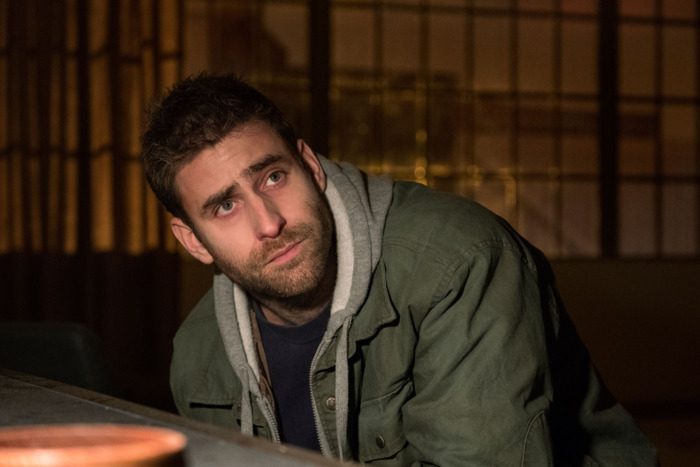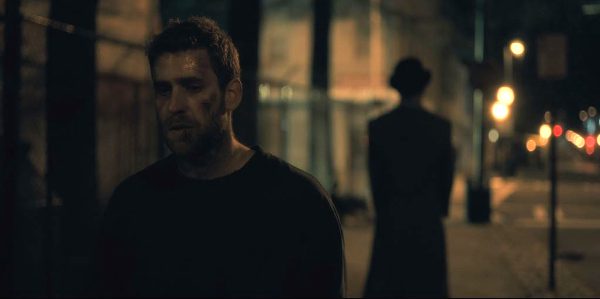One of the most successful parts of The Haunting of Hill House is how authentic and lived-in everything feels. The adult actors not only resemble their child counterparts, but at times they echo their performances. We never see the Crain family moving into Hill House; for the purposes of the story, they’ve always lived there. But what really hammers this home is the way that creator and director Mike Flanagan is unafraid of giving long monologues to one-off characters, showing that people outside the Crains have their own interiority, their own ghosts. In “Steven Sees a Ghost,” we were treated to a heartbreaking, terrifying monologue from Saidah Arrika Ekulona; in “The Twin Thing” we meet Gordon, a blind addict at Luke’s rehab facility, who relates a story of hauntings and self-mutilation.
As played by Nelson Bonilla, Gordon is a fully-formed character, giving a movie’s worth of backstory in just a few minutes. Flanagan’s camera remains steady on Bonilla, giving him and the monologue room to breathe. It shows the trust that Flanagan has in both his cast and his viewers. Through Gordon, he can continue to play with his universal themes of memory. “Twenty-four seven I see her face,” Gordon says of a dead girl he saw while he was in Iraq. “Shit, I see it now.”
It’s easy to see why Gordon gets so long to speak. The idea of seeing what no one else does is huge in this show, and it appears to afflict Luke more than others. “The Twin Thing” opens with him complaining to his friend Abigail that no one believes him about the ghoul in the basement. It’s a quick scene, but it shows us that Abigail is not imaginary. She’s there, and we can see her too. In Hill House, the ghosts are real. Add Abigail to their number. Although this does, unfortunately, go along with Flanagan’s habit of throwing every kind of ghost that he can at the screen. It’s effective, because he’s such an astute visual storyteller, but – and I wrote about this in my review of “Touch” – it seems to lack internal logic. More on this later.
If “Touch” was the show’s scariest episode to date, “The Twin Thing” might be its saddest. (Although it’s certainly in the running for scariest as well.) Luke Crain’s story of addiction and relapse has tragedy baked into it, but saddest of all might be his connection to poor departed Nell. Once we find out they’re twins, we start to wonder just how inextricably their fates are entwined. The show underscores this nicely, introducing a kind of empathetic telepathy between them. “I know your’e scared,” Nell tells Luke at one point. When he asks how she knows, she responds: “Cause I’m scared.”
Once again, Hill House is fixated on empathy, and here Luke shows it towards his friend in rehab, Joey (Anna Enger, terrific). She leaves during the night, and Luke goes to find her, getting himself kicked out of rehab in turn. What we see in “The Twin Thing” is the mirror image of what we saw in “Steven Sees a Ghost.” Flanagan subtly frames each individual episode through his characters’ worldviews, and I’d love to go back and see if the other actors are portraying their characters differently – does Oliver Jackson Cohen, as Luke, act differently in “Steven Sees a Ghost,” to reflect Steven’s idea of who Luke is? One slight drawback to the focused episodes is that the farther we get from Steven’s, the more of a jerk he looks like. Luke didn’t run away from rehab, he went looking for a friend. He wasn’t robbing Steven for drug money, but to pay for a hotel room. He wasn’t cold because of withdrawals, but because he was just in a room with Nell’s ghost. These are the parts of lives we never get to see, the parts we wouldn’t believe even if they were told to us.
And there we go, circling back to belief. Luke has this innate desire to believe – in Abigail, in the ghoul, in the floating man – and that’s what makes reality so impermanent for him. Real vs. imaginary is a huge factor in “The Twin Thing,” whether it’s belief in the supernatural or only in each other. Steven doesn’t even bother to ask why Luke is carrying an armful of his possessions; in “Open Casket,” Shirley hardly lets Luke out of the taxi before shoving money in his face and kicking him out of Nell’s wedding. Luke is someone that the world has given up on. As a kid, he arranges little plastic Army men in squadrons of seven, to ward off evil. As an adult, he counts to seven to stave off anxiety. “We’re only as sick as our secrets,” Joey tells him, and Luke’s sickness follows him around wherever he goes.
The floating man is maybe Hill House‘s most frightening creation yet. It doesn’t necessarily conform to the ghosts we’ve seen so far, but nothing does. Part of me gives Flanagan credit for trying whatever he wants, but another part of me is a little frustrated at the lack of cohesion between the apparitions. It doesn’t matter here. The floating man is an instantly iconic creation, his feet a few inches off the floor as he propels himself forward with the tip of his cane, searching for his hat. When the floating man is in Luke’s bedroom, it’s one of the most exhilirating parts of the episode, the kind of full-body terror from which you can’t look away, the kind that tells you that you are in the hands of a genuine artist. The floating man follows Luke after that, always with his back turned, like a shadow.
It’s here, in “The Twin Thing,” that Mike Flanagan’s approach to The Haunting of Hill House becomes clear. The first four episodes have arguably been a prologue, which is an incredibly risky move. This all just gets us to the point where everyone learns of Nell’s death. It could be a show within itself. But the ghosts of Hill House are older, more pernicious – they may be benign or malicious, but they are always there. Luke can add one more to his list: Nell. When he’s told that her death was a suicide, he only has one thing to say: “No it wasn’t.” It’s the twin thing.
4/5
A Few Thoughts
- I consider It to be a pretty successful movie, but one thing it lacks that made the book so great was the cross-cutting between the characters as kids and as adults. The Haunting of Hill House is absolutely nailing that.
- This show managed to find the weirdest-looking dog I’ve ever seen.
- “Everyone deserves peace!”



